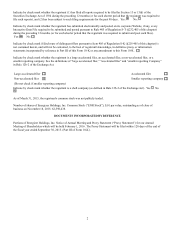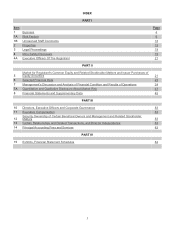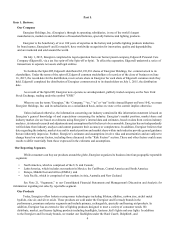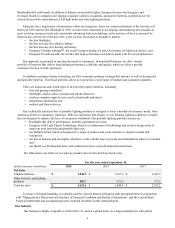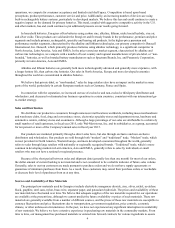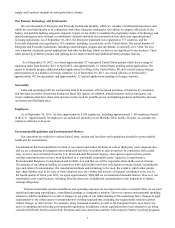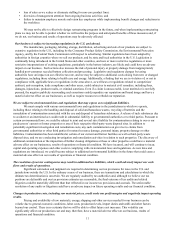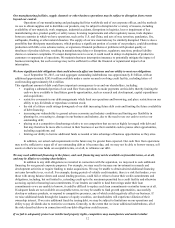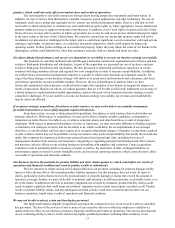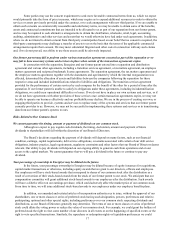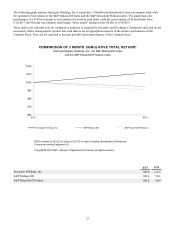Energizer 2015 Annual Report Download - page 16
Download and view the complete annual report
Please find page 16 of the 2015 Energizer annual report below. You can navigate through the pages in the report by either clicking on the pages listed below, or by using the keyword search tool below to find specific information within the annual report.12
Our manufacturing facilities, supply channels or other business operations may be subject to disruption from events
beyond our control.
Operations of our manufacturing and packaging facilities worldwide and of our corporate offices, and the methods
we use to obtain supplies and to distribute our products, may be subject to disruption for a variety of reasons, including
availability of raw materials, work stoppages, industrial accidents, disruptions in logistics, loss or impairment of key
manufacturing sites, product quality or safety issues, licensing requirements and other regulatory issues, trade disputes
between countries in which we have operations, such as the U.S. and China, and acts of war, terrorism, pandemics, fire,
earthquake, flooding or other natural disasters. The supply of our raw materials may be similarly disrupted. There is also a
possibility that third-party manufacturers, which produce a significant portion of certain of our products, could discontinue
production with little or no advance notice, or experience financial problems or problems with product quality or
timeliness of product delivery, resulting in manufacturing delays or disruptions, regulatory sanctions, product liability
claims or consumer complaints. If a major disruption were to occur, it could result in delays in shipments of products to
customers or suspension of operations. We maintain business interruption insurance to potentially mitigate the impact of
business interruption, but such coverage may not be sufficient to offset the financial or reputational impact of an
interruption.
We have significant debt obligations that could adversely affect our business and our ability to meet our obligations.
As of September 30, 2015, our total aggregate outstanding indebtedness was approximately $1 billion, with an
additional approximately $243.6 million available under a senior secured revolving credit facility, excluding letters of
credit totaling approximately $6.4 million.
This significant amount of debt could have important consequences to us and our shareholders, including:
• requiring a substantial portion of our cash flow from operations to make payments on this debt, thereby limiting the
cash we have available to fund future growth opportunities, such as research and development, capital expenditures
and acquisitions;
• restrictive covenants in our debt arrangements which limit our operations and borrowing, and place restrictions on our
ability to pay dividends or repurchase common stock;
• the risk of a future credit ratings downgrade of our debt increasing future debt costs and limiting the future availability
of debt financing;
• increasing our vulnerability to general adverse economic and industry conditions and limiting our flexibility in
planning for, or reacting to, changes in our business and industry, due to the need to use our cash to service our
outstanding debt;
• placing us at a competitive disadvantage relative to our competitors that are not as highly leveraged with debt and
that may therefore be more able to invest in their business or use their available cash to pursue other opportunities,
including acquisitions; and
• limiting our ability to borrow additional funds as needed or take advantage of business opportunities as they arise.
In addition, our actual cash requirements in the future may be greater than expected. Our cash flow from operations
may not be sufficient to repay all of our outstanding debt as it becomes due, and we may not be able to borrow money, sell
assets or otherwise raise funds on acceptable terms, or at all, to refinance our debt.
We may need additional financing in the future, and such financing may not be available on favorable terms, or at all,
and may be dilutive to existing shareholders.
In addition to any debt obligations we incurred in connection with the separation, we may need to seek additional
financing for our general corporate purposes. For example, we may need to increase our investment in research and
development activities or require funding to make acquisitions. We may be unable to obtain desired additional financing
on terms favorable to us, or at all. For example, during periods of volatile credit markets, there is a risk that lenders, even
those with strong balance sheets and sound lending practices, could fail or refuse to honor their credit commitments and
obligations, including, but not limited to, extending credit up to the maximum permitted by a credit facility and otherwise
accessing capital or honoring loan commitments. If our lenders are unable to fund borrowings under their loan
commitments or we are unable to borrow, it could be difficult to replace such loan commitments on similar terms or at all.
If adequate funds are not available on acceptable terms, we may be unable to fund growth opportunities, successfully
develop or enhance products, or respond to competitive pressures, any of which could negatively affect our business. If
we raise additional funds through the issuance of equity securities, our shareholders will experience dilution of their
ownership interest. If we raise additional funds by issuing debt, we may be subject to limitations on our operations and
ability to pay dividends due to restrictive covenants. Generally, to the extent that we incur additional indebtedness, all of
the risks described above in connection with our debt obligations could increase.
If we fail to adequately protect our intellectual property rights, competitors may manufacture and market similar


